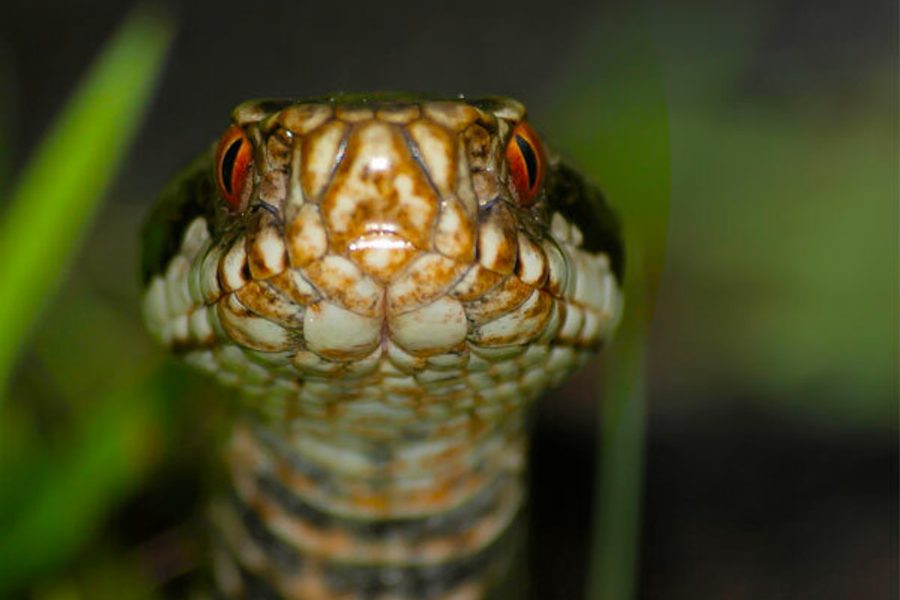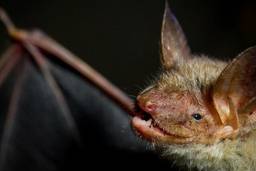The House of Reptile Lovers
Snakes, lizards and crocodiles should be worshipped—not fashion accessories.
Dawn Starin

Marchesa, Mulberry, Balenciaga, Chloe, Prada, Manolo Blahnik, Dior, Fendi, Chanel, Gucci, Calvin Klein, Coach, YSL. For many people these labels whisper, “I am wealthy” or “I have arrived” or “I am glamorous.” But for me, these labels shriek, “I am uninformed and cruel and crass.”
The design firms listed above are among those who make millions selling reptile accessories. Marchesa’s designer Georgina Chapman (married to Harvey Weinstein) told the Wall Street Journal that her most recent collection “follows Miss Havisham’s eternal plight” by using python skin “to create ‘Great Expectations’ of classic opulence, both ethereal and romantic.” And Miuccia Prada, the head designer of Prada, told the Daily Telegraph that she considers python skins “sexy”. Unfortunately, the more “sexy” and chic these products become, the more reptiles die.
Every year millions of reptiles are killed, processed and manufactured into products for the international reptile skin trade. Traffic, a wildlife trade monitoring organization, estimates that from 2000 to 2005, 3.4 million lizard, 2.9 million crocodile, and 3.4 million snake skins – all species listed under the Convention on International Trade in Endangered Species – were imported into the European Union. According to the United Nations Environmental Programme (UNEP) World Conservation Monitoring Centre, 1.2 million crocodile, caiman and alligator skins entered international trade in 2008. And these numbers do not include snake and lizard skins. As the Wall Street Journal observes, exotic reptile skins are “increasingly common.” Unfortunately, the more common they become, the more wild populations are affected.
Some of the magnificent dead creatures now decorating the bodies of the fashionistas come from reptile farms, but most are taken from wild fragile ecosystems. Animals Asia maintains that up to 90 percent of all snakeskins come from snakes caught in the wild, and the United Nations Environmental Programme determined that in 2007, 69 percent of skins imported into the European Union were sourced from wild populations.
Removing reptiles from the wild can be devastating to an ecosystem. The depletion of one species can have profound effects on others. The taking of wild pythons in Asia for shoes, handbags, and clothing has reportedly resulted in infestations of rats, which spread disease to humans and damage crops.
No matter where they come from, however, these animals have often gone through an extremely cruel death. Many of the skins you see displayed in the shop windows or being carried down the high-end streets of New York, London, Los Angeles, Milan and Paris were stripped from their original owners whilst the animal was still alive. Many people working in the reptile trade claim the animals are “cold blooded” and are not capable of feeling pain. But reptiles are not “cold blooded.” They are ectothermic – meaning they possess only a very limited ability to regulate their own body temperature, so their body temperature is largely determined by the ambient outside temperature. Their nervous systems respond to painful stimuli in ways that mirror those of mammals (including our own). Veterinarians specializing in reptiles recognize their ability to feel pain, and insist on the use of analgesia during any potentially painful procedures.
And unbeknownst to most fashionistas. These creatures are also capable of an elaborate – actually quite hot – social life. They are sexy, though not in the way imagined by Miuccia Prada.
Sex in the jungle
I spent years watching and researching the red colobus monkeys in The Gambia, but it was often the weird and wonderful reptiles that fascinated me the most. Every day a reptilian character took center stage. Every day a different story unfolded. Every day I received a special present from the forest.
It is strange how every little sighting stays with me forever. Over the years the landscape became marked by these reptilian magical visions. The sump in the path where the eyes of the endangered dwarf crocodiles watched me jump over their retreat. The lantana scrub hiding a dead python with a dead adult female colobus in its belly. A pool where an adult crocodile swam around for days with a dead green monkey rotting in its mouth while a half dozen baby crocodiles hitched rides on its head and back and ripped off chunks of putrid green monkey meat. The clearing where six pythons spent hours sliding over, under and around each other taking part in a marvelous orgy.
Once it was two lime green chameleons mating on a sandy grey path. These strange creatures, with tongues longer than their bodies, contorted into one lump, both of them looking in two different directions at the same time, were totally oblivious to me. Taking risks, they could have easily been preyed upon by any snake or bird, trod on by any human or antelope or simply been attacked by the nearby line of safari ants. Oblivious to all the potential dangers around them, they just kept going at it.
It was these brief snippets of life that kept me plodding on and on. These were my miracles, my personal little marvels – the things I never saw coming. Being a devotee of reptile worship, but definitely not an expert, my day was never really complete unless I had a reptilian sighting.
During the dry season the mambas, puff adders and pythons moved around the reserve looking for sex. The slender green mambas wriggle and squirm with their mates up in the branches of the trees. The well-camouflaged entwined puff adders hide under logs on the forest floor and the pythons mate down on the ground in writhing balls.
Rock pythons are in a class of their own. It is, after all, a bit unnerving to be confronted with 21 feet of slithering muscle. Although their vision is poor and they don’t have ears, their senses are finely tuned. They can see infrared, feel vibrations and sense chemical stimuli or smell with their super-sensitive forked tongues. Their immensely stretchy skin, mobile jaws and more than 300 vertebrate enable them to catch and feed on prey as large as their own body size while their metabolism makes it possible for them to go months without eating. In short, they are perfectly adapted to feasting and famine. They are not “evil.” Their forked tongues and slithering movements are not synonymous with evil; they are adaptations for a perfect hunting system.
The pythons are probably one of the Nile crocodile’s major food sources. Over the years I have seen crocodiles and pythons wrestling in the pools. The pythons always end up losing.
The crocodiles were no less amazing. I would sit by a lily-pad covered pool and watch the crocodiles. These dominance-obsessed reptiles engage in spectacular battles: spraying water, slapping tails, leaping out of the pool and crashing down again and chasing each other from shore to shore. And occasionally I was treated to a full-scale romantic interlude. Except for their sporadic snorting, their mating rituals resemble a synchronized ballet of nudging, submerging, tail waving and slapping and floating. These strange reptiles, gentle parents, fierce antagonists and balletic lovers rolled into one, once shared the world with T. Rex and brontosaurus. They are now an ancient presence in the 21st century. Once they were worshipped. Now they are hunted, slain, tanned and worn as shoes or carried as handbags.
‘Nothing like the real thing’
Today, far away from the Gambian forest, I receive another reptile present, a not-so-nice present, in the middle of trendy Islington in north London. I am listening to a female shop assistant and a male customer.
He: (pointing to a row of wallets): Is that real crocodile skin?
She: No, unfortunately they’re fake.
He: There is nothing like the real thing. I used to have a real one but it was stolen, so I need to replace it. Why would someone make fake ones?
She: I know. It’s such a shame. There is nothing like the real thing.
Me: (I want to explain in a measured voice that reptiles are declining throughout the world, that they can feel pain and that they are often subjected to unimaginable cruelty. I want to change their perception of reptiles. Instead, unable to control myself, my banshee voice takes over and I shriek): Have you ever considered that it might be better for the reptiles if they’re left in their natural habitat and aren’t used for draining your bank balance and massaging your fashion ego?
I immediately know that rather than draw another parishioner into the house of reptile lovers, I have alienated them.

I hope you found this article important. Before you leave, I want to ask you to consider supporting our work with a donation. In These Times needs readers like you to help sustain our mission. We don’t depend on—or want—corporate advertising or deep-pocketed billionaires to fund our journalism. We’re supported by you, the reader, so we can focus on covering the issues that matter most to the progressive movement without fear or compromise.
Our work isn’t hidden behind a paywall because of people like you who support our journalism. We want to keep it that way. If you value the work we do and the movements we cover, please consider donating to In These Times.






